BIO Worksheet - University Biology: Immunity, Homeostasis, Physiology
VerifiedAdded on 2023/01/19
|16
|3461
|44
Homework Assignment
AI Summary
This biology worksheet assesses understanding of human physiology and immunology through a series of questions. The assignment covers topics including types of immunity, properties of adaptive immunity, hormone regulation of blood calcium, the function of the medulla oblongata, autonomic nervous system effects, muscle contraction, the renin-angiotensin-aldosterone system, baroreceptor function, normal sinus rhythm, and haemophilia. Additionally, the worksheet explores the effects of alcohol on ADH secretion and urine output, and the three elementary steps of urine formation. The questions require students to apply their knowledge to various scenarios and explain physiological processes.
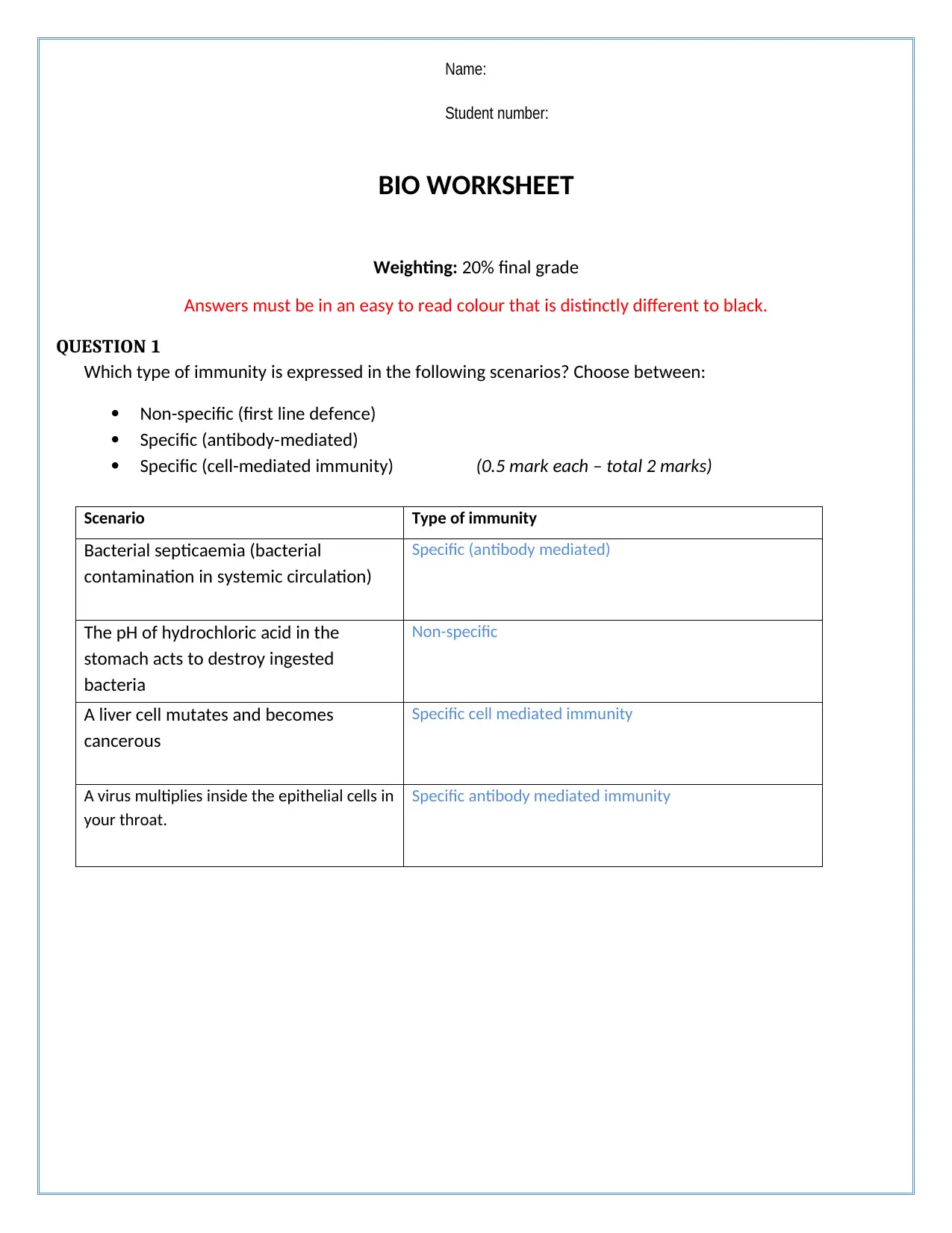
Name:
Student number:
BIO WORKSHEET
Weighting: 20% final grade
Answers must be in an easy to read colour that is distinctly different to black.
QUESTION 1
Which type of immunity is expressed in the following scenarios? Choose between:
Non-specific (first line defence)
Specific (antibody-mediated)
Specific (cell-mediated immunity) (0.5 mark each – total 2 marks)
Scenario Type of immunity
Bacterial septicaemia (bacterial
contamination in systemic circulation)
Specific (antibody mediated)
The pH of hydrochloric acid in the
stomach acts to destroy ingested
bacteria
Non-specific
A liver cell mutates and becomes
cancerous
Specific cell mediated immunity
A virus multiplies inside the epithelial cells in
your throat.
Specific antibody mediated immunity
Student number:
BIO WORKSHEET
Weighting: 20% final grade
Answers must be in an easy to read colour that is distinctly different to black.
QUESTION 1
Which type of immunity is expressed in the following scenarios? Choose between:
Non-specific (first line defence)
Specific (antibody-mediated)
Specific (cell-mediated immunity) (0.5 mark each – total 2 marks)
Scenario Type of immunity
Bacterial septicaemia (bacterial
contamination in systemic circulation)
Specific (antibody mediated)
The pH of hydrochloric acid in the
stomach acts to destroy ingested
bacteria
Non-specific
A liver cell mutates and becomes
cancerous
Specific cell mediated immunity
A virus multiplies inside the epithelial cells in
your throat.
Specific antibody mediated immunity
Paraphrase This Document
Need a fresh take? Get an instant paraphrase of this document with our AI Paraphraser

QUESTION2
Choose TWO of the below scenarios and highlight these rowsbold. State which general property of
adaptive immunity the scenario illustrates in the second column. Select ONE phrase (from the list
below) that BEST describes what is happening at a cellular level to result in this property of adaptive
immunity. Write the letter corresponding to this phrase in the third column. An example is included.
(2 mark)
Scenario General
property of
immunity
Explanation
Even though your body contains a relatively small number of
lymphocytes, your immune system can mount a response
against almost any antigen it encounters.
Versatility A
Generally, after an initial infection, subsequent immune
responses to that antigen are faster, stronger and more
sustained.
Memory
mediated C
You can suffer from ‘the flu’ multiple times throughout your
lifetime.
Antigen
specificity B
Your immune system can distinguish between antigens on your
own cells, and those of an invading pathogen.
Self
recognition G
Possible phrases are listed below. Not all phrases will need to be used and only ONE phrase is required
per row. If you record more than one, you will not be awarded any marks for your explanation.
A There are millions of different lymphocyte populations, each of which is sensitive to a different antigen.
Lymphocytes proliferate when activated by their specific antigen.
B Each T or B cell has receptors that respond to only one antigen and ignores all others.
C Activated lymphocytes produce two groups of cells: one group that attacks the invader immediately, and
another that remains inactive unless it is exposed to the same antigen at a later date.
D Each T and B cell can recognise many antigens and respond to a wide variety of possible threats.
E T cells are versatile because they produce copious quantities of antibodies that can respond to a wide
variety of threats.
F Phagocytes have a reduced ability to destroy pathogens during subsequent infections.
G The immune response ignores self-antigens and targets non-self antigens.
H B cells differentiate into T cells to create a long-lived immune response.
2
Choose TWO of the below scenarios and highlight these rowsbold. State which general property of
adaptive immunity the scenario illustrates in the second column. Select ONE phrase (from the list
below) that BEST describes what is happening at a cellular level to result in this property of adaptive
immunity. Write the letter corresponding to this phrase in the third column. An example is included.
(2 mark)
Scenario General
property of
immunity
Explanation
Even though your body contains a relatively small number of
lymphocytes, your immune system can mount a response
against almost any antigen it encounters.
Versatility A
Generally, after an initial infection, subsequent immune
responses to that antigen are faster, stronger and more
sustained.
Memory
mediated C
You can suffer from ‘the flu’ multiple times throughout your
lifetime.
Antigen
specificity B
Your immune system can distinguish between antigens on your
own cells, and those of an invading pathogen.
Self
recognition G
Possible phrases are listed below. Not all phrases will need to be used and only ONE phrase is required
per row. If you record more than one, you will not be awarded any marks for your explanation.
A There are millions of different lymphocyte populations, each of which is sensitive to a different antigen.
Lymphocytes proliferate when activated by their specific antigen.
B Each T or B cell has receptors that respond to only one antigen and ignores all others.
C Activated lymphocytes produce two groups of cells: one group that attacks the invader immediately, and
another that remains inactive unless it is exposed to the same antigen at a later date.
D Each T and B cell can recognise many antigens and respond to a wide variety of possible threats.
E T cells are versatile because they produce copious quantities of antibodies that can respond to a wide
variety of threats.
F Phagocytes have a reduced ability to destroy pathogens during subsequent infections.
G The immune response ignores self-antigens and targets non-self antigens.
H B cells differentiate into T cells to create a long-lived immune response.
2
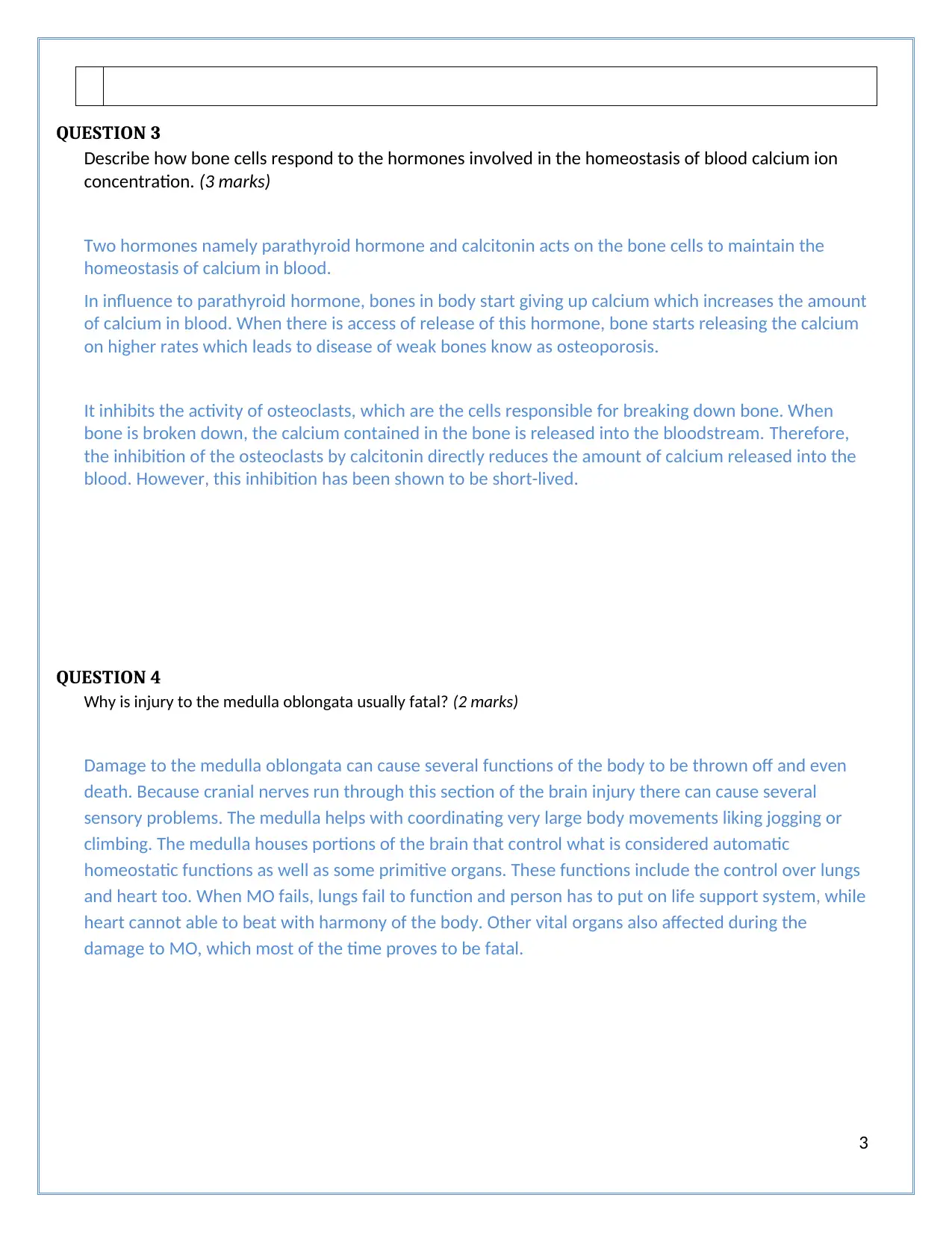
QUESTION 3
Describe how bone cells respond to the hormones involved in the homeostasis of blood calcium ion
concentration. (3 marks)
Two hormones namely parathyroid hormone and calcitonin acts on the bone cells to maintain the
homeostasis of calcium in blood.
In influence to parathyroid hormone, bones in body start giving up calcium which increases the amount
of calcium in blood. When there is access of release of this hormone, bone starts releasing the calcium
on higher rates which leads to disease of weak bones know as osteoporosis.
It inhibits the activity of osteoclasts, which are the cells responsible for breaking down bone. When
bone is broken down, the calcium contained in the bone is released into the bloodstream. Therefore,
the inhibition of the osteoclasts by calcitonin directly reduces the amount of calcium released into the
blood. However, this inhibition has been shown to be short-lived.
QUESTION 4
Why is injury to the medulla oblongata usually fatal? (2 marks)
Damage to the medulla oblongata can cause several functions of the body to be thrown off and even
death. Because cranial nerves run through this section of the brain injury there can cause several
sensory problems. The medulla helps with coordinating very large body movements liking jogging or
climbing. The medulla houses portions of the brain that control what is considered automatic
homeostatic functions as well as some primitive organs. These functions include the control over lungs
and heart too. When MO fails, lungs fail to function and person has to put on life support system, while
heart cannot able to beat with harmony of the body. Other vital organs also affected during the
damage to MO, which most of the time proves to be fatal.
3
Describe how bone cells respond to the hormones involved in the homeostasis of blood calcium ion
concentration. (3 marks)
Two hormones namely parathyroid hormone and calcitonin acts on the bone cells to maintain the
homeostasis of calcium in blood.
In influence to parathyroid hormone, bones in body start giving up calcium which increases the amount
of calcium in blood. When there is access of release of this hormone, bone starts releasing the calcium
on higher rates which leads to disease of weak bones know as osteoporosis.
It inhibits the activity of osteoclasts, which are the cells responsible for breaking down bone. When
bone is broken down, the calcium contained in the bone is released into the bloodstream. Therefore,
the inhibition of the osteoclasts by calcitonin directly reduces the amount of calcium released into the
blood. However, this inhibition has been shown to be short-lived.
QUESTION 4
Why is injury to the medulla oblongata usually fatal? (2 marks)
Damage to the medulla oblongata can cause several functions of the body to be thrown off and even
death. Because cranial nerves run through this section of the brain injury there can cause several
sensory problems. The medulla helps with coordinating very large body movements liking jogging or
climbing. The medulla houses portions of the brain that control what is considered automatic
homeostatic functions as well as some primitive organs. These functions include the control over lungs
and heart too. When MO fails, lungs fail to function and person has to put on life support system, while
heart cannot able to beat with harmony of the body. Other vital organs also affected during the
damage to MO, which most of the time proves to be fatal.
3
⊘ This is a preview!⊘
Do you want full access?
Subscribe today to unlock all pages.

Trusted by 1+ million students worldwide

QUESTION 5
Complete the following table summarising the effects of autonomic innervation on target tissues. You
must include both the effect upon the target tissue and a consequence of this stimulation in your
answer.
The first row has been completed as an example. (1 mark/box; 4 marks total)
Target tissue Effect of sympathetic stimulation Effect of parasympathetic stimulation
Contractile
force of the
heart
Contractile force increases; more blood
pumped from heart
No parasympathetic innervation of
ventricular myocardium; therefore, no
result
Airways in
the lungs
Relaxation of bronchial muscles of lungs
which dilate the airway in lungs.
Contraction of the bronchial muscles of
lungs which constrict the airway in lungs.
Pupil Due to contraction of the radial muscles of
iris, pupil will dilate.
Due to contraction of the circular muscles
of iris, pupil will constrict.
QUESTION6
Using the diagram provided as a prompt, outline the four steps involved in the transmission of an
electrical impulse from the presynaptic neurone to the post synaptic neurone. (4 marks)
4
Complete the following table summarising the effects of autonomic innervation on target tissues. You
must include both the effect upon the target tissue and a consequence of this stimulation in your
answer.
The first row has been completed as an example. (1 mark/box; 4 marks total)
Target tissue Effect of sympathetic stimulation Effect of parasympathetic stimulation
Contractile
force of the
heart
Contractile force increases; more blood
pumped from heart
No parasympathetic innervation of
ventricular myocardium; therefore, no
result
Airways in
the lungs
Relaxation of bronchial muscles of lungs
which dilate the airway in lungs.
Contraction of the bronchial muscles of
lungs which constrict the airway in lungs.
Pupil Due to contraction of the radial muscles of
iris, pupil will dilate.
Due to contraction of the circular muscles
of iris, pupil will constrict.
QUESTION6
Using the diagram provided as a prompt, outline the four steps involved in the transmission of an
electrical impulse from the presynaptic neurone to the post synaptic neurone. (4 marks)
4
Paraphrase This Document
Need a fresh take? Get an instant paraphrase of this document with our AI Paraphraser
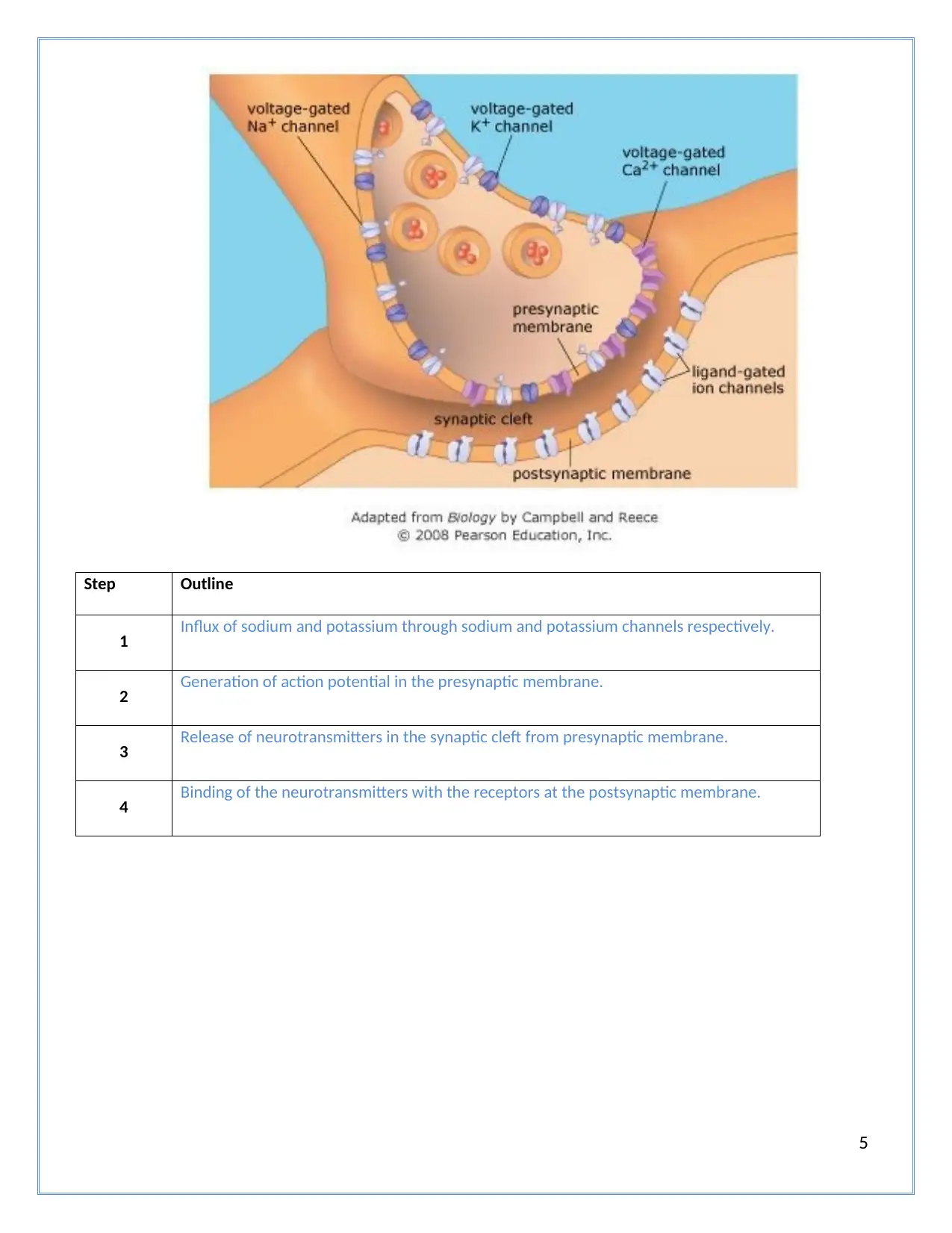
Step Outline
1 Influx of sodium and potassium through sodium and potassium channels respectively.
2 Generation of action potential in the presynaptic membrane.
3 Release of neurotransmitters in the synaptic cleft from presynaptic membrane.
4 Binding of the neurotransmitters with the receptors at the postsynaptic membrane.
5
1 Influx of sodium and potassium through sodium and potassium channels respectively.
2 Generation of action potential in the presynaptic membrane.
3 Release of neurotransmitters in the synaptic cleft from presynaptic membrane.
4 Binding of the neurotransmitters with the receptors at the postsynaptic membrane.
5
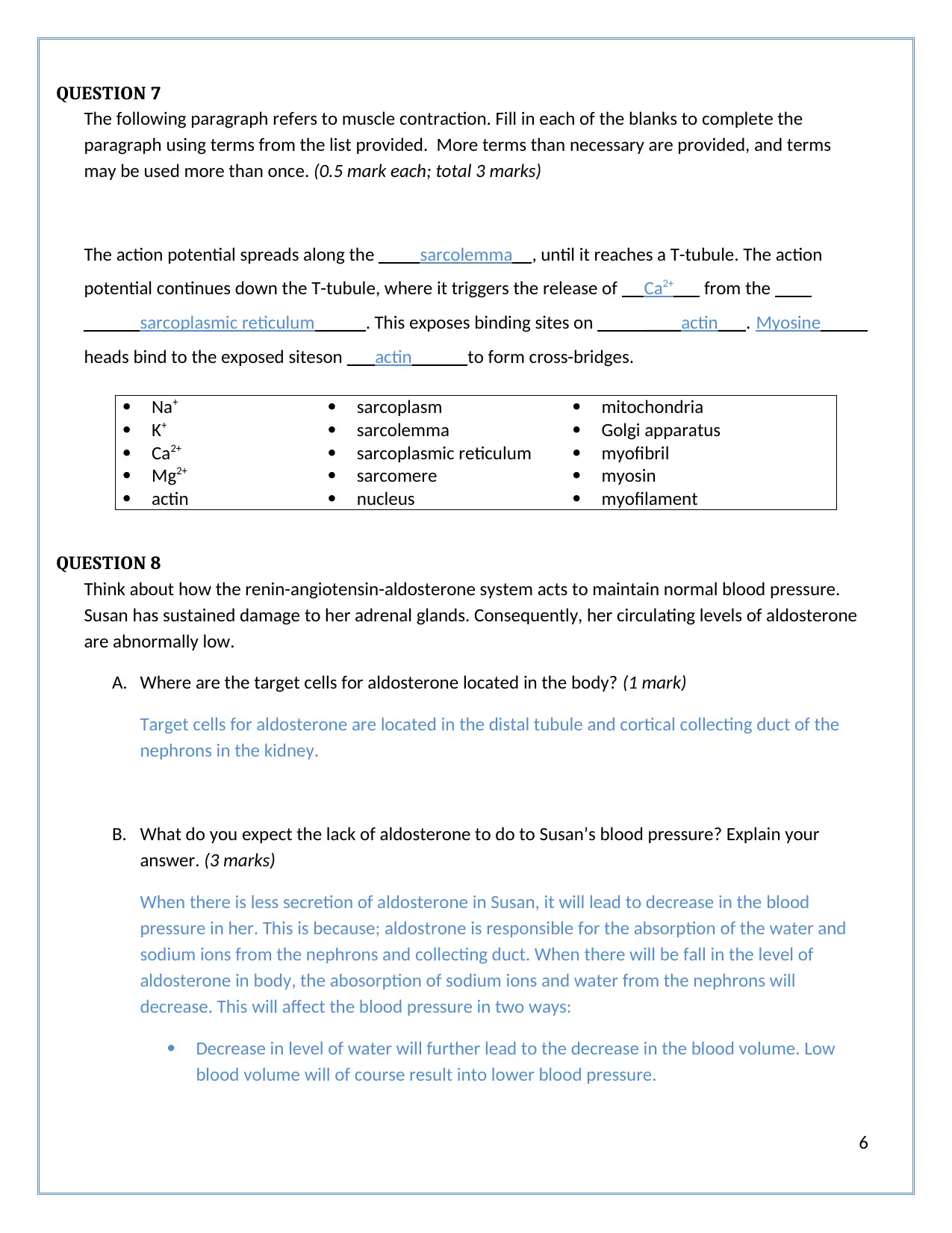
QUESTION 7
The following paragraph refers to muscle contraction. Fill in each of the blanks to complete the
paragraph using terms from the list provided. More terms than necessary are provided, and terms
may be used more than once. (0.5 mark each; total 3 marks)
The action potential spreads along the sarcolemma , until it reaches a T-tubule. The action
potential continues down the T-tubule, where it triggers the release of Ca2+ from the
sarcoplasmic reticulum _____. This exposes binding sites on ____actin___. Myosine
heads bind to the exposed siteson ___actin______to form cross-bridges.
Na+ sarcoplasm mitochondria
K+ sarcolemma Golgi apparatus
Ca2+
Mg2+
sarcoplasmic reticulum
sarcomere
myofibril
myosin
actin nucleus myofilament
QUESTION 8
Think about how the renin-angiotensin-aldosterone system acts to maintain normal blood pressure.
Susan has sustained damage to her adrenal glands. Consequently, her circulating levels of aldosterone
are abnormally low.
A. Where are the target cells for aldosterone located in the body? (1 mark)
Target cells for aldosterone are located in the distal tubule and cortical collecting duct of the
nephrons in the kidney.
B. What do you expect the lack of aldosterone to do to Susan’s blood pressure? Explain your
answer. (3 marks)
When there is less secretion of aldosterone in Susan, it will lead to decrease in the blood
pressure in her. This is because; aldostrone is responsible for the absorption of the water and
sodium ions from the nephrons and collecting duct. When there will be fall in the level of
aldosterone in body, the abosorption of sodium ions and water from the nephrons will
decrease. This will affect the blood pressure in two ways:
Decrease in level of water will further lead to the decrease in the blood volume. Low
blood volume will of course result into lower blood pressure.
6
The following paragraph refers to muscle contraction. Fill in each of the blanks to complete the
paragraph using terms from the list provided. More terms than necessary are provided, and terms
may be used more than once. (0.5 mark each; total 3 marks)
The action potential spreads along the sarcolemma , until it reaches a T-tubule. The action
potential continues down the T-tubule, where it triggers the release of Ca2+ from the
sarcoplasmic reticulum _____. This exposes binding sites on ____actin___. Myosine
heads bind to the exposed siteson ___actin______to form cross-bridges.
Na+ sarcoplasm mitochondria
K+ sarcolemma Golgi apparatus
Ca2+
Mg2+
sarcoplasmic reticulum
sarcomere
myofibril
myosin
actin nucleus myofilament
QUESTION 8
Think about how the renin-angiotensin-aldosterone system acts to maintain normal blood pressure.
Susan has sustained damage to her adrenal glands. Consequently, her circulating levels of aldosterone
are abnormally low.
A. Where are the target cells for aldosterone located in the body? (1 mark)
Target cells for aldosterone are located in the distal tubule and cortical collecting duct of the
nephrons in the kidney.
B. What do you expect the lack of aldosterone to do to Susan’s blood pressure? Explain your
answer. (3 marks)
When there is less secretion of aldosterone in Susan, it will lead to decrease in the blood
pressure in her. This is because; aldostrone is responsible for the absorption of the water and
sodium ions from the nephrons and collecting duct. When there will be fall in the level of
aldosterone in body, the abosorption of sodium ions and water from the nephrons will
decrease. This will affect the blood pressure in two ways:
Decrease in level of water will further lead to the decrease in the blood volume. Low
blood volume will of course result into lower blood pressure.
6
⊘ This is a preview!⊘
Do you want full access?
Subscribe today to unlock all pages.

Trusted by 1+ million students worldwide
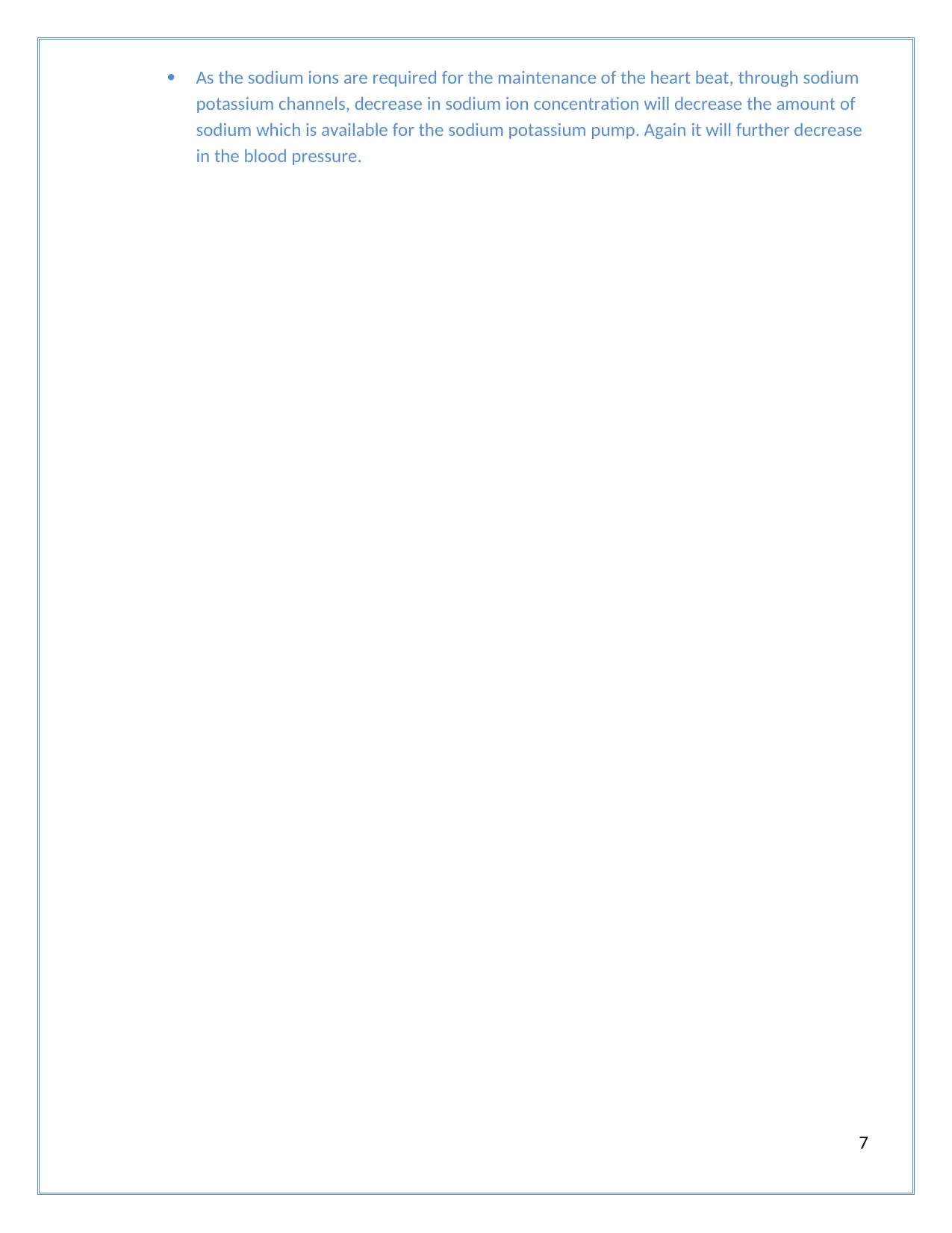
As the sodium ions are required for the maintenance of the heart beat, through sodium
potassium channels, decrease in sodium ion concentration will decrease the amount of
sodium which is available for the sodium potassium pump. Again it will further decrease
in the blood pressure.
7
potassium channels, decrease in sodium ion concentration will decrease the amount of
sodium which is available for the sodium potassium pump. Again it will further decrease
in the blood pressure.
7
Paraphrase This Document
Need a fresh take? Get an instant paraphrase of this document with our AI Paraphraser
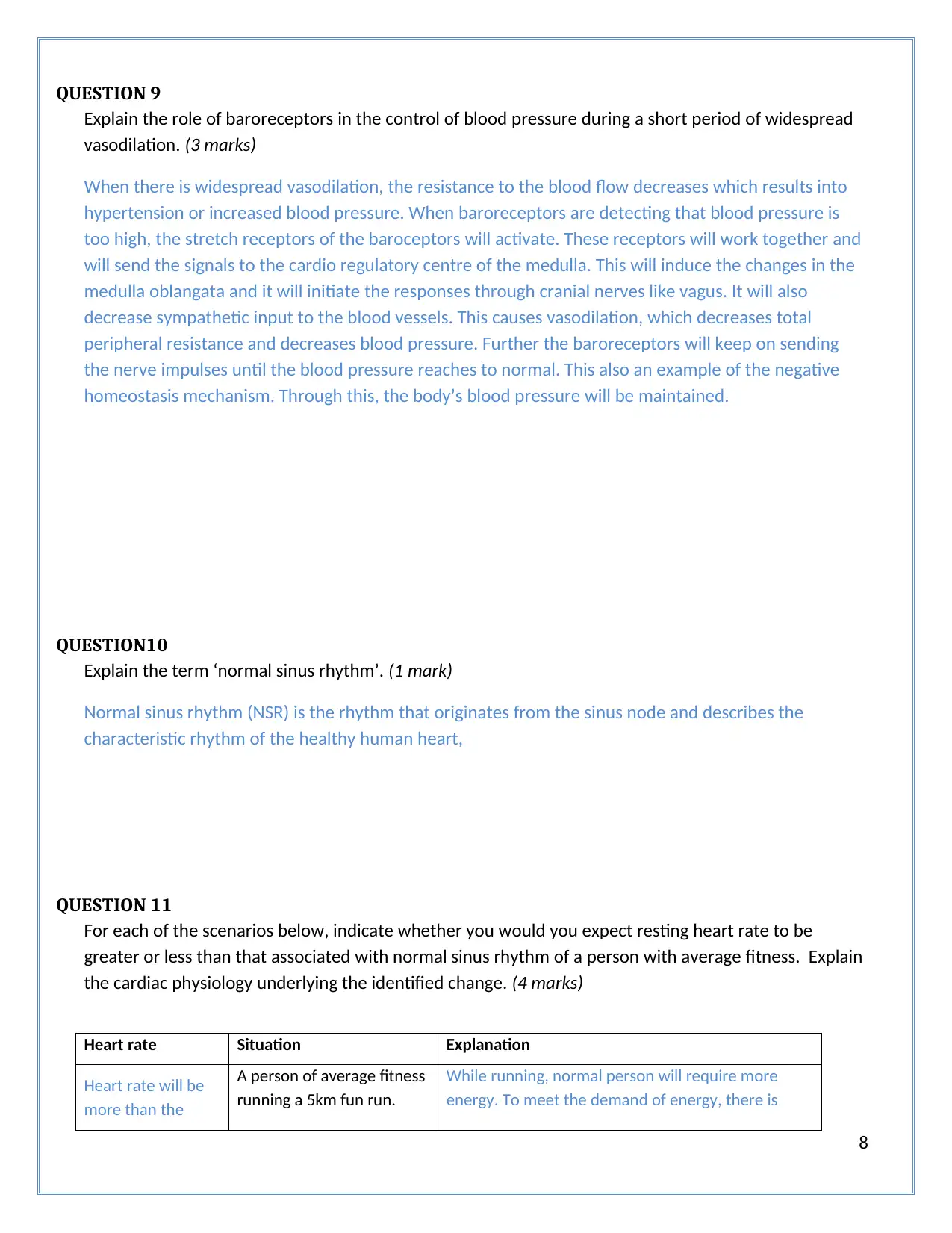
QUESTION 9
Explain the role of baroreceptors in the control of blood pressure during a short period of widespread
vasodilation. (3 marks)
When there is widespread vasodilation, the resistance to the blood flow decreases which results into
hypertension or increased blood pressure. When baroreceptors are detecting that blood pressure is
too high, the stretch receptors of the baroceptors will activate. These receptors will work together and
will send the signals to the cardio regulatory centre of the medulla. This will induce the changes in the
medulla oblangata and it will initiate the responses through cranial nerves like vagus. It will also
decrease sympathetic input to the blood vessels. This causes vasodilation, which decreases total
peripheral resistance and decreases blood pressure. Further the baroreceptors will keep on sending
the nerve impulses until the blood pressure reaches to normal. This also an example of the negative
homeostasis mechanism. Through this, the body’s blood pressure will be maintained.
QUESTION10
Explain the term ‘normal sinus rhythm’. (1 mark)
Normal sinus rhythm (NSR) is the rhythm that originates from the sinus node and describes the
characteristic rhythm of the healthy human heart,
QUESTION 11
For each of the scenarios below, indicate whether you would you expect resting heart rate to be
greater or less than that associated with normal sinus rhythm of a person with average fitness. Explain
the cardiac physiology underlying the identified change. (4 marks)
Heart rate Situation Explanation
Heart rate will be
more than the
A person of average fitness
running a 5km fun run.
While running, normal person will require more
energy. To meet the demand of energy, there is
8
Explain the role of baroreceptors in the control of blood pressure during a short period of widespread
vasodilation. (3 marks)
When there is widespread vasodilation, the resistance to the blood flow decreases which results into
hypertension or increased blood pressure. When baroreceptors are detecting that blood pressure is
too high, the stretch receptors of the baroceptors will activate. These receptors will work together and
will send the signals to the cardio regulatory centre of the medulla. This will induce the changes in the
medulla oblangata and it will initiate the responses through cranial nerves like vagus. It will also
decrease sympathetic input to the blood vessels. This causes vasodilation, which decreases total
peripheral resistance and decreases blood pressure. Further the baroreceptors will keep on sending
the nerve impulses until the blood pressure reaches to normal. This also an example of the negative
homeostasis mechanism. Through this, the body’s blood pressure will be maintained.
QUESTION10
Explain the term ‘normal sinus rhythm’. (1 mark)
Normal sinus rhythm (NSR) is the rhythm that originates from the sinus node and describes the
characteristic rhythm of the healthy human heart,
QUESTION 11
For each of the scenarios below, indicate whether you would you expect resting heart rate to be
greater or less than that associated with normal sinus rhythm of a person with average fitness. Explain
the cardiac physiology underlying the identified change. (4 marks)
Heart rate Situation Explanation
Heart rate will be
more than the
A person of average fitness
running a 5km fun run.
While running, normal person will require more
energy. To meet the demand of energy, there is
8
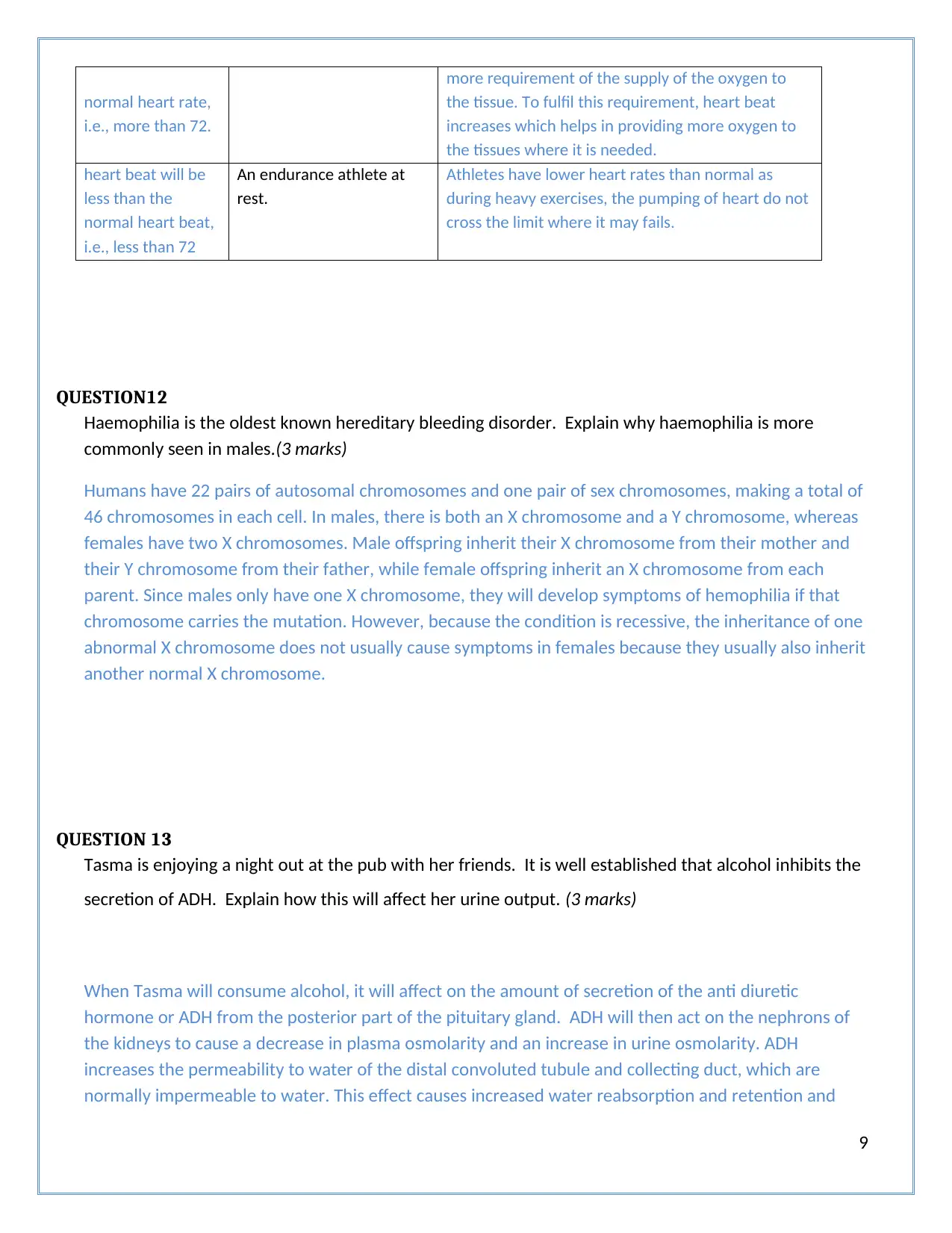
normal heart rate,
i.e., more than 72.
more requirement of the supply of the oxygen to
the tissue. To fulfil this requirement, heart beat
increases which helps in providing more oxygen to
the tissues where it is needed.
heart beat will be
less than the
normal heart beat,
i.e., less than 72
An endurance athlete at
rest.
Athletes have lower heart rates than normal as
during heavy exercises, the pumping of heart do not
cross the limit where it may fails.
QUESTION12
Haemophilia is the oldest known hereditary bleeding disorder. Explain why haemophilia is more
commonly seen in males.(3 marks)
Humans have 22 pairs of autosomal chromosomes and one pair of sex chromosomes, making a total of
46 chromosomes in each cell. In males, there is both an X chromosome and a Y chromosome, whereas
females have two X chromosomes. Male offspring inherit their X chromosome from their mother and
their Y chromosome from their father, while female offspring inherit an X chromosome from each
parent. Since males only have one X chromosome, they will develop symptoms of hemophilia if that
chromosome carries the mutation. However, because the condition is recessive, the inheritance of one
abnormal X chromosome does not usually cause symptoms in females because they usually also inherit
another normal X chromosome.
QUESTION 13
Tasma is enjoying a night out at the pub with her friends. It is well established that alcohol inhibits the
secretion of ADH. Explain how this will affect her urine output. (3 marks)
When Tasma will consume alcohol, it will affect on the amount of secretion of the anti diuretic
hormone or ADH from the posterior part of the pituitary gland. ADH will then act on the nephrons of
the kidneys to cause a decrease in plasma osmolarity and an increase in urine osmolarity. ADH
increases the permeability to water of the distal convoluted tubule and collecting duct, which are
normally impermeable to water. This effect causes increased water reabsorption and retention and
9
i.e., more than 72.
more requirement of the supply of the oxygen to
the tissue. To fulfil this requirement, heart beat
increases which helps in providing more oxygen to
the tissues where it is needed.
heart beat will be
less than the
normal heart beat,
i.e., less than 72
An endurance athlete at
rest.
Athletes have lower heart rates than normal as
during heavy exercises, the pumping of heart do not
cross the limit where it may fails.
QUESTION12
Haemophilia is the oldest known hereditary bleeding disorder. Explain why haemophilia is more
commonly seen in males.(3 marks)
Humans have 22 pairs of autosomal chromosomes and one pair of sex chromosomes, making a total of
46 chromosomes in each cell. In males, there is both an X chromosome and a Y chromosome, whereas
females have two X chromosomes. Male offspring inherit their X chromosome from their mother and
their Y chromosome from their father, while female offspring inherit an X chromosome from each
parent. Since males only have one X chromosome, they will develop symptoms of hemophilia if that
chromosome carries the mutation. However, because the condition is recessive, the inheritance of one
abnormal X chromosome does not usually cause symptoms in females because they usually also inherit
another normal X chromosome.
QUESTION 13
Tasma is enjoying a night out at the pub with her friends. It is well established that alcohol inhibits the
secretion of ADH. Explain how this will affect her urine output. (3 marks)
When Tasma will consume alcohol, it will affect on the amount of secretion of the anti diuretic
hormone or ADH from the posterior part of the pituitary gland. ADH will then act on the nephrons of
the kidneys to cause a decrease in plasma osmolarity and an increase in urine osmolarity. ADH
increases the permeability to water of the distal convoluted tubule and collecting duct, which are
normally impermeable to water. This effect causes increased water reabsorption and retention and
9
⊘ This is a preview!⊘
Do you want full access?
Subscribe today to unlock all pages.

Trusted by 1+ million students worldwide
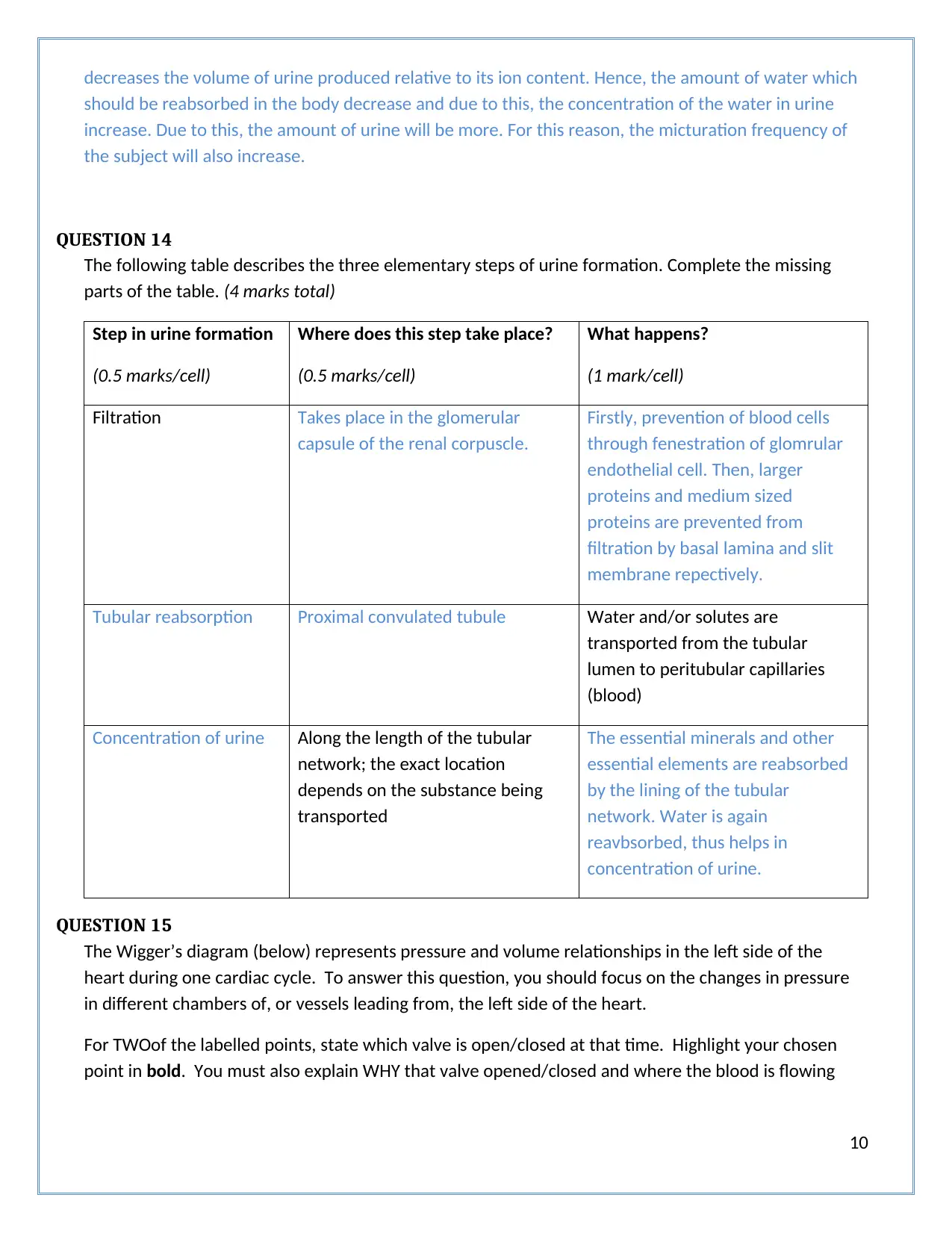
decreases the volume of urine produced relative to its ion content. Hence, the amount of water which
should be reabsorbed in the body decrease and due to this, the concentration of the water in urine
increase. Due to this, the amount of urine will be more. For this reason, the micturation frequency of
the subject will also increase.
QUESTION 14
The following table describes the three elementary steps of urine formation. Complete the missing
parts of the table. (4 marks total)
Step in urine formation
(0.5 marks/cell)
Where does this step take place?
(0.5 marks/cell)
What happens?
(1 mark/cell)
Filtration Takes place in the glomerular
capsule of the renal corpuscle.
Firstly, prevention of blood cells
through fenestration of glomrular
endothelial cell. Then, larger
proteins and medium sized
proteins are prevented from
filtration by basal lamina and slit
membrane repectively.
Tubular reabsorption Proximal convulated tubule Water and/or solutes are
transported from the tubular
lumen to peritubular capillaries
(blood)
Concentration of urine Along the length of the tubular
network; the exact location
depends on the substance being
transported
The essential minerals and other
essential elements are reabsorbed
by the lining of the tubular
network. Water is again
reavbsorbed, thus helps in
concentration of urine.
QUESTION 15
The Wigger’s diagram (below) represents pressure and volume relationships in the left side of the
heart during one cardiac cycle. To answer this question, you should focus on the changes in pressure
in different chambers of, or vessels leading from, the left side of the heart.
For TWOof the labelled points, state which valve is open/closed at that time. Highlight your chosen
point in bold. You must also explain WHY that valve opened/closed and where the blood is flowing
10
should be reabsorbed in the body decrease and due to this, the concentration of the water in urine
increase. Due to this, the amount of urine will be more. For this reason, the micturation frequency of
the subject will also increase.
QUESTION 14
The following table describes the three elementary steps of urine formation. Complete the missing
parts of the table. (4 marks total)
Step in urine formation
(0.5 marks/cell)
Where does this step take place?
(0.5 marks/cell)
What happens?
(1 mark/cell)
Filtration Takes place in the glomerular
capsule of the renal corpuscle.
Firstly, prevention of blood cells
through fenestration of glomrular
endothelial cell. Then, larger
proteins and medium sized
proteins are prevented from
filtration by basal lamina and slit
membrane repectively.
Tubular reabsorption Proximal convulated tubule Water and/or solutes are
transported from the tubular
lumen to peritubular capillaries
(blood)
Concentration of urine Along the length of the tubular
network; the exact location
depends on the substance being
transported
The essential minerals and other
essential elements are reabsorbed
by the lining of the tubular
network. Water is again
reavbsorbed, thus helps in
concentration of urine.
QUESTION 15
The Wigger’s diagram (below) represents pressure and volume relationships in the left side of the
heart during one cardiac cycle. To answer this question, you should focus on the changes in pressure
in different chambers of, or vessels leading from, the left side of the heart.
For TWOof the labelled points, state which valve is open/closed at that time. Highlight your chosen
point in bold. You must also explain WHY that valve opened/closed and where the blood is flowing
10
Paraphrase This Document
Need a fresh take? Get an instant paraphrase of this document with our AI Paraphraser
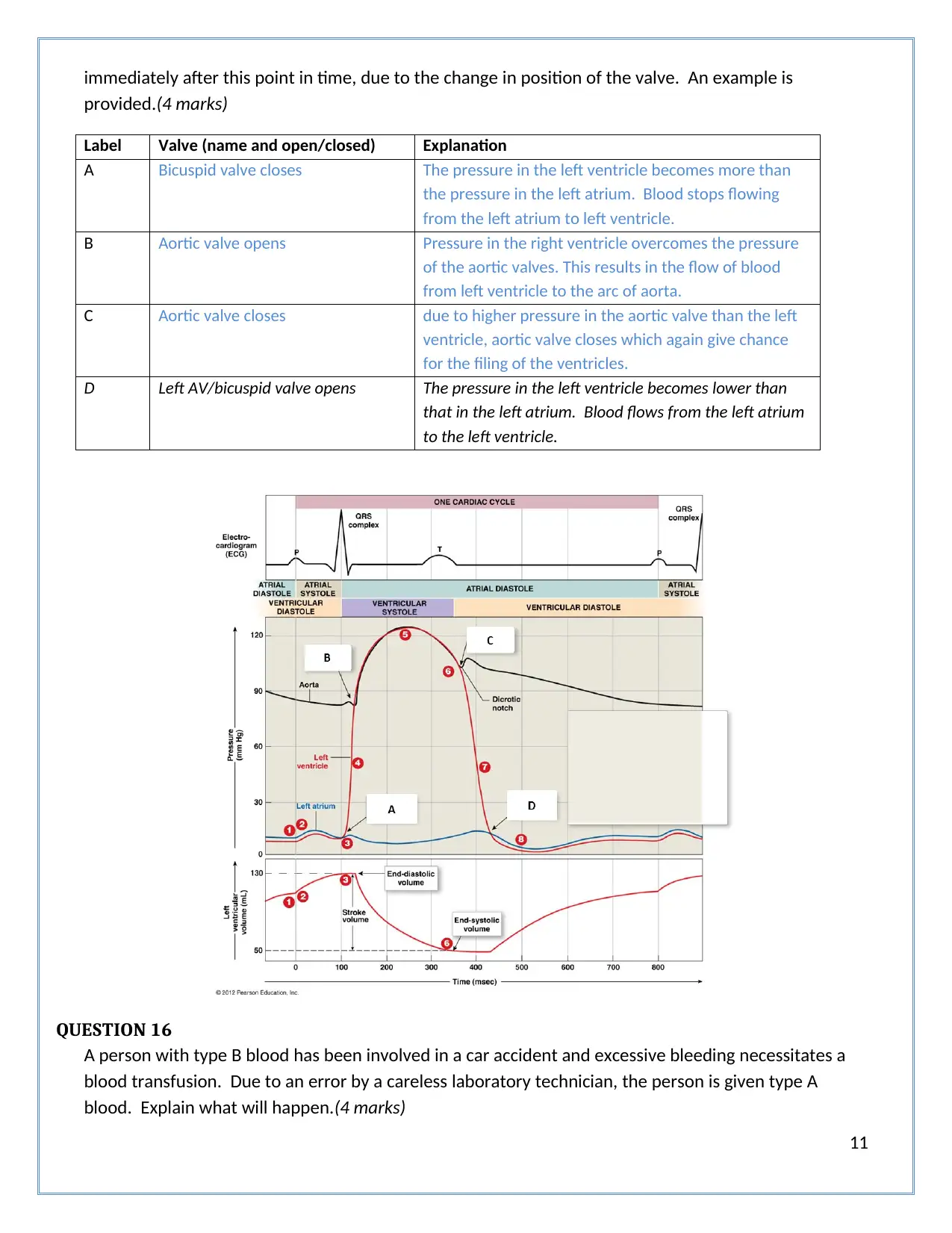
immediately after this point in time, due to the change in position of the valve. An example is
provided.(4 marks)
Label Valve (name and open/closed) Explanation
A Bicuspid valve closes The pressure in the left ventricle becomes more than
the pressure in the left atrium. Blood stops flowing
from the left atrium to left ventricle.
B Aortic valve opens Pressure in the right ventricle overcomes the pressure
of the aortic valves. This results in the flow of blood
from left ventricle to the arc of aorta.
C Aortic valve closes due to higher pressure in the aortic valve than the left
ventricle, aortic valve closes which again give chance
for the filing of the ventricles.
D Left AV/bicuspid valve opens The pressure in the left ventricle becomes lower than
that in the left atrium. Blood flows from the left atrium
to the left ventricle.
QUESTION 16
A person with type B blood has been involved in a car accident and excessive bleeding necessitates a
blood transfusion. Due to an error by a careless laboratory technician, the person is given type A
blood. Explain what will happen.(4 marks)
11
provided.(4 marks)
Label Valve (name and open/closed) Explanation
A Bicuspid valve closes The pressure in the left ventricle becomes more than
the pressure in the left atrium. Blood stops flowing
from the left atrium to left ventricle.
B Aortic valve opens Pressure in the right ventricle overcomes the pressure
of the aortic valves. This results in the flow of blood
from left ventricle to the arc of aorta.
C Aortic valve closes due to higher pressure in the aortic valve than the left
ventricle, aortic valve closes which again give chance
for the filing of the ventricles.
D Left AV/bicuspid valve opens The pressure in the left ventricle becomes lower than
that in the left atrium. Blood flows from the left atrium
to the left ventricle.
QUESTION 16
A person with type B blood has been involved in a car accident and excessive bleeding necessitates a
blood transfusion. Due to an error by a careless laboratory technician, the person is given type A
blood. Explain what will happen.(4 marks)
11
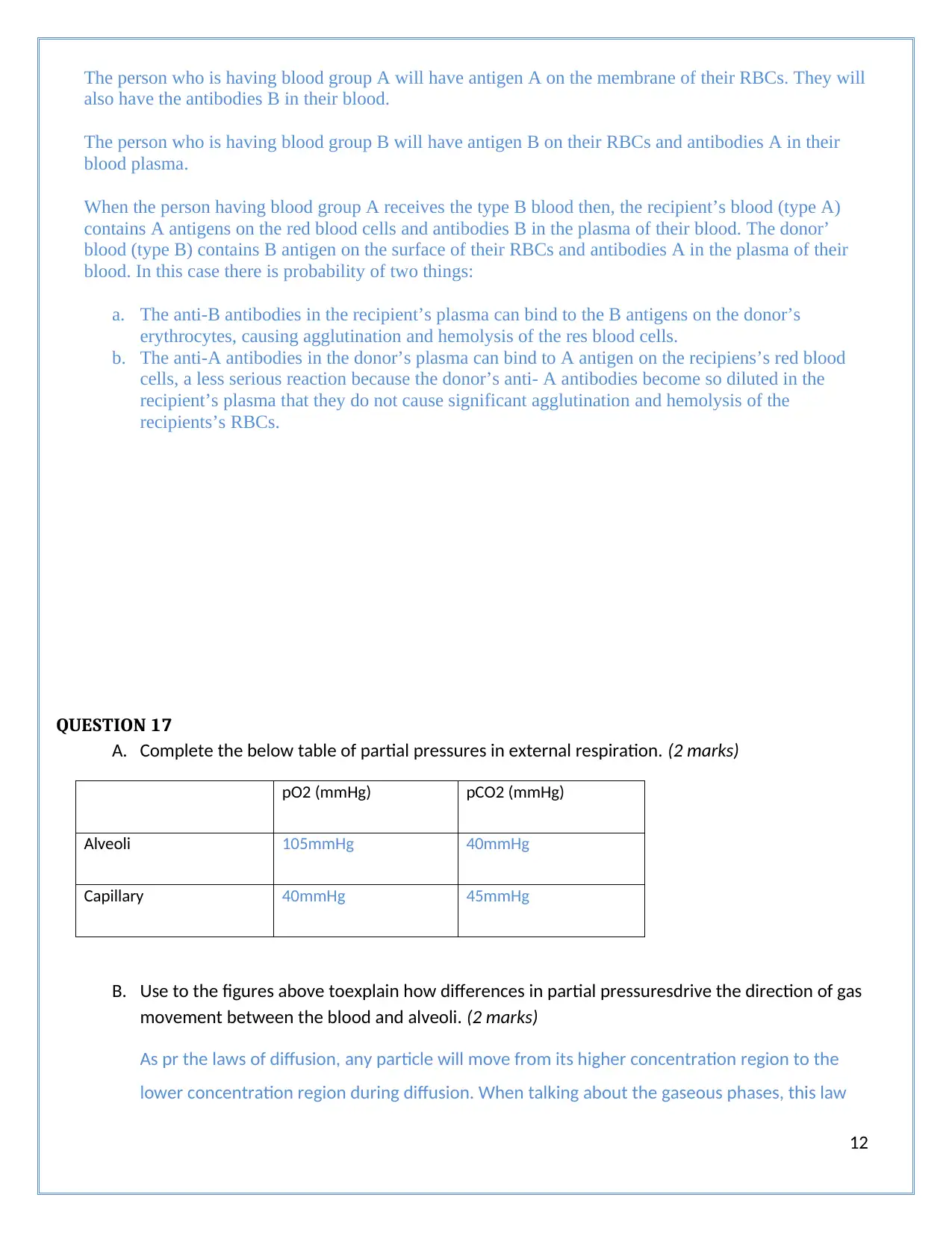
The person who is having blood group A will have antigen A on the membrane of their RBCs. They will
also have the antibodies B in their blood.
The person who is having blood group B will have antigen B on their RBCs and antibodies A in their
blood plasma.
When the person having blood group A receives the type B blood then, the recipient’s blood (type A)
contains A antigens on the red blood cells and antibodies B in the plasma of their blood. The donor’
blood (type B) contains B antigen on the surface of their RBCs and antibodies A in the plasma of their
blood. In this case there is probability of two things:
a. The anti-B antibodies in the recipient’s plasma can bind to the B antigens on the donor’s
erythrocytes, causing agglutination and hemolysis of the res blood cells.
b. The anti-A antibodies in the donor’s plasma can bind to A antigen on the recipiens’s red blood
cells, a less serious reaction because the donor’s anti- A antibodies become so diluted in the
recipient’s plasma that they do not cause significant agglutination and hemolysis of the
recipients’s RBCs.
QUESTION 17
A. Complete the below table of partial pressures in external respiration. (2 marks)
pO2 (mmHg) pCO2 (mmHg)
Alveoli 105mmHg 40mmHg
Capillary 40mmHg 45mmHg
B. Use to the figures above toexplain how differences in partial pressuresdrive the direction of gas
movement between the blood and alveoli. (2 marks)
As pr the laws of diffusion, any particle will move from its higher concentration region to the
lower concentration region during diffusion. When talking about the gaseous phases, this law
12
also have the antibodies B in their blood.
The person who is having blood group B will have antigen B on their RBCs and antibodies A in their
blood plasma.
When the person having blood group A receives the type B blood then, the recipient’s blood (type A)
contains A antigens on the red blood cells and antibodies B in the plasma of their blood. The donor’
blood (type B) contains B antigen on the surface of their RBCs and antibodies A in the plasma of their
blood. In this case there is probability of two things:
a. The anti-B antibodies in the recipient’s plasma can bind to the B antigens on the donor’s
erythrocytes, causing agglutination and hemolysis of the res blood cells.
b. The anti-A antibodies in the donor’s plasma can bind to A antigen on the recipiens’s red blood
cells, a less serious reaction because the donor’s anti- A antibodies become so diluted in the
recipient’s plasma that they do not cause significant agglutination and hemolysis of the
recipients’s RBCs.
QUESTION 17
A. Complete the below table of partial pressures in external respiration. (2 marks)
pO2 (mmHg) pCO2 (mmHg)
Alveoli 105mmHg 40mmHg
Capillary 40mmHg 45mmHg
B. Use to the figures above toexplain how differences in partial pressuresdrive the direction of gas
movement between the blood and alveoli. (2 marks)
As pr the laws of diffusion, any particle will move from its higher concentration region to the
lower concentration region during diffusion. When talking about the gaseous phases, this law
12
⊘ This is a preview!⊘
Do you want full access?
Subscribe today to unlock all pages.

Trusted by 1+ million students worldwide
1 out of 16
Related Documents
Your All-in-One AI-Powered Toolkit for Academic Success.
+13062052269
info@desklib.com
Available 24*7 on WhatsApp / Email
![[object Object]](/_next/static/media/star-bottom.7253800d.svg)
Unlock your academic potential
Copyright © 2020–2025 A2Z Services. All Rights Reserved. Developed and managed by ZUCOL.





